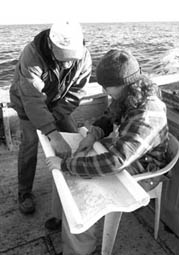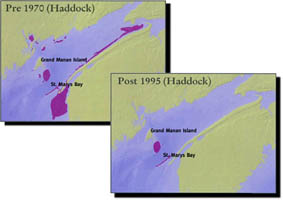
![]()
Volume 6, No. 4
Promoting Cooperation to Maintain and Enhance
Environmental Quality in the Gulf of Maine
|
|
|
|
|
|
|
|
|||||||
|
|
|
|
Browse the archive |
|
|
|
|
Scientists, managers could learn from fishermen’s first-hand knowledge, study finds
By Jennifer Graham & Maria Recchia
Terry Farnsworth, a handliner from Digby Neck, Nova Scotia, has spent hundreds of hours each year fishing for groundfish from his 45-foot boat, even living on his boat for a week or more at a time. As a result, Farnsworth has spent a lot of time in the marine environment observing fish life cycles, the characteristics of different groups of fish and their migration patterns. First-hand experience like his can help fisheries managers better understand fish stocks. Until recently, however, fisheries managers have not collected knowledge from fishermen because it is difficult to validate the information.
 |
| Terry Farnsworth (standing) points out spawning areas to Airin Stephens, of the Centre for Community-Based Management. Photo: Charles Levkoe |
But as the traditional Bay of Fundy inshore fisheries for cod, haddock and pollock disappear, it is has become increasingly important to find out more about groundfish stocks. Fundy fishermen believe that their traditional coastal fisheries relied on local stocks that formed the backbone for year-round inshore fisheries. These local stocks have declined significantly as have their inshore spawning areas.
In a recent two-year project we documented the knowledge of Fundy fishermen to identify local groundfish stocks in the Bay of Fundy. A local stock is a distinguishable group of fish of a certain species. For example, longline fishermen from Saint John Harbour report that a distinct group of cod arrives in the area in April chasing the spring gaspareau (alewife) run. These “gaspareau cod” are described as longer, skinnier and paler than other cod fish caught in the same area earlier and later in the season.
Local stocks can be identified by their spawning patterns, so in this study, we looked for evidence of spawning within the Bay of Fundy to identify local stocks of cod, haddock and pollock.
Many scientists say that most groundfish spawn on the offshore banks like Georges and Browns and that any spawning that happens inside the Bay of Fundy is not important to fish stocks. This is not what fishermen believe. In several interviews, fishermen told us about inshore areas such as Passamaquoddy Bay, Musquash Shoals and Saint Marys Bay where fish spawned year after year and where the inshore fisheries collapsed after adjacent spawning grounds were fished out.
In recent years, the Gulf of Maine Council on the Marine Environment has supported two projects to identify groundfish spawning areas in the Gulf of Maine. Ted Ames, a fisherman and researcher from Maine, interviewed retired fishing captains and found many discrete coastal cod and haddock spawning grounds from Maine to Massachusetts. Many of these spawning grounds are gone. In the Bay of Fundy and Scotian Shelf, Arlene Benham and Ed Trippel, of the Canadian Department of Fisheries and Oceans (DFO), interviewed fishermen about spawning activity for a number of species. They identified many general areas associated with groundfish spawning.
Our project builds on the earlier work of Benham and Trippel and a study by the Conservation Council of New Brunswick on spawning grounds off southwest New Brunswick. Following the direction that fishermen set during our planning meetings, our research focused on obtaining more specific information about previously identified groundfish spawning areas. Through numerous interviews with active and retired fishermen, we documented and mapped more precise locations and timing of spawning. For example, we identified spring, summer and fall haddock spawning at specific locations within and close to Saint Marys such as McDormand Patch, Cape Saint Marys and Lurcher and Trinity Shoals. We also considered evidence for local stocks, characteristics of spawning habitat and the potential reasons for the decline of local fisheries and spawning grounds.
We found many areas where fishermen reported spawning cod, haddock and pollock in the Bay of Fundy. These included general areas such as the Grand Manan Plate and Shipping Lane, as well as more specific locations such as Kent Shoal or Heart Shaped Shoal that can be found within the more general spawning areas. Many of the spawning grounds were in coastal areas, like Passamaquoddy Bay, and linked to formerly productive fishing grounds, like the Bulkhead. We were able to confirm most of the spawning grounds identified in earlier studies as well as add many new sites, such as the River (in Passamaquoddy Bay) and Ile Haute (in the Upper Bay).
On the offshore banks, cod and haddock generally spawn in the spring. But we found evidence that different groups of groundfish spawn in the Bay at other times of year. Cod did spawn in the coastal waters in the spring, and in other parts of the Bay of Fundy during the fall. Fishermen reported similar patterns of spring and fall spawning for haddock as well. This means there were once a few local stock groupings within the Bay, and that overall stock structure is complicated and not yet fully understood.
Time is running out to better understand these fish stocks. We found a significant loss of active spawning grounds. The maps shown here illustrate a dramatic decline in spawning areas for haddock over the last 50 years. Both cod and pollock follow a similar trend.
The few remaining active spawning areas for all three species have some common features. For example, they are all fairly difficult to access, farther from shore than many of the lost coastal spawning areas, and characterized by strong currents and irregular bottom topography. The active spawning areas are also places that fishermen associated with winter spawning, where weather limits access. Lastly, most fishermen we interviewed felt that these remaining spawning areas are threatened by overexploitation and should be protected.
We hope that this project will raise awareness about the value of local knowledge. Fishermen such as Terry Farnsworth have a great wealth of information to share. It is a community resource that should be given a prominent role in fisheries management. If the decline in inshore fisheries is not reversed, we will lose both the remaining local fish stocks and the knowledge of the fishermen who depend on them. This report is intended to spark interest in further research, and inspire action to protect and rehabilitate inshore fisheries.
Copies of Local Knowledge and Local Stocks: An atlas of groundfish spawning in the Bay of Fundy by Jennifer Graham, Stephen Engle and Maria Recchia, Centre for Community-based Management, can be obtained from the St. Francis Xavier University Bookstore, (902) 867-2450, fax (902) 867-5115, or by e-mail at: bkstore@stfx.ca .
 |
| The maps show the decline of haddock spawing grounds in the Bay of Fundy over the past several decades. Maps by Centre for Community-Based Management
Click on the picture to enlarge. |
The Centre for Community- based Management (CCBM) is a joint initiative of the Extension Department and the Coady International Institute at St. Francis Xavier University in Antigonish, Nova Scotia. The Centre’s work in the Bay of Fundy is supported by the Henry P. Kendall Foundation. The Bay of Fundy program focuses on capacity building, knowledge management and participatory research with local fishing communities. Participatory research is always driven by the needs and interests of community partners; in this case, fishermen’s desire to document evidence of local groundfish stocks in the Bay of Fundy.